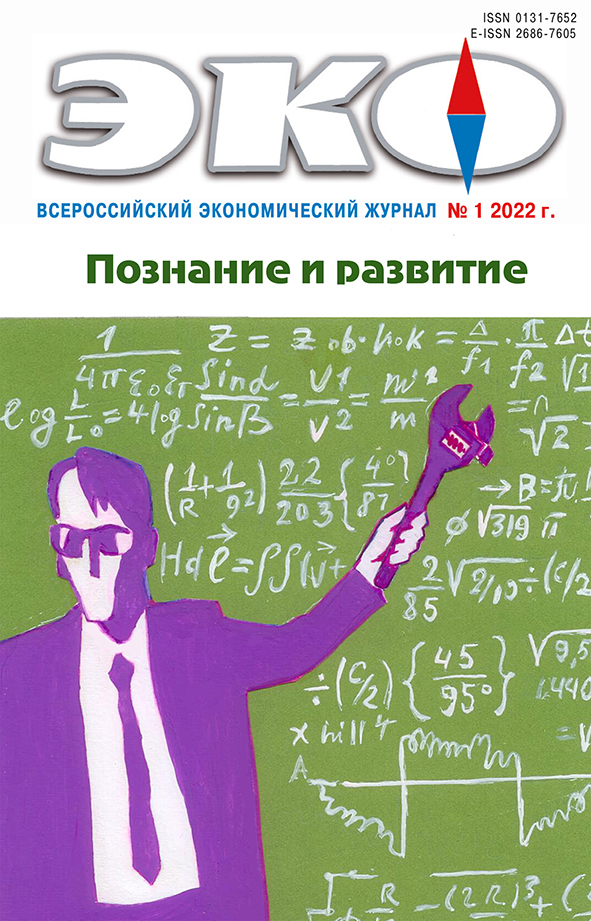FINANCIAL ECONOMY
Published 2021-12-29
Keywords
- crowdfunding; public funding; innovations; NIS; factor analysis
How to Cite
1.
Gordeev М. Implicit Mechanisms of Crowdfunding in Russia and Abroad. ECO [Internet]. 2021 Dec. 29 [cited 2025 Dec. 22];52(1):77-95. Available from: https://ecotrends.ru/index.php/eco/article/view/4367
Abstract
The present paper focuses on the dynamics of crowdfunding development. The data made it possible to determine the reasons for the sluggish development of some of its models, to deepen our understanding of the motivations of sponsors, and to explain the influence of the Jobs Act on the development of the nonfinancial model of crowdfunding in the USA. Moreover, such research data could explain the specialization of crowd platforms in the world practice. This research identifies four patterns of participation of Russians in crowdfunding projects. Considering the broad prospects of using crowdfunding as a tool for financing scientific research, as well as innovative business, the paper will be useful not only for professionals in the crowdfunding market, but also for a wide audience of readers, and can also be used in the development of strategy for embedding crowdfunding mechanism in the activities of the National Innovation System.References
- Веселовский М. Я. Краудфандинг в России: состояние и возможности стимулирования инновационных стартапов // Инновационное развитие экономики. 2016. № 2. С. 7–13.
- Гордеев М. Н. Мотивация участников краудфандинговых проектов в сфере науки и просвещения // ЭКО. 2018. № 11. С. 158–170. DOI: 10.30680/ЕСО0131–7652–2018–11–158–170.
- Гордеев М. Н. Факторы, определяющие склонность россиян к участию в краудфандинге // Информационное общество. 2019. № 1–2. С. 6–15.
- Зубков И., Швабауэр Н. Вложить стало веселей. Объем рынка краудфандинга превысил 7 млрд рублей // Российская газета. 2021. № 36 (8387)
- Мотовилов О. В. Феномен краудфандинга: исследование особенностей / О. В. Мотовилов // Вестник Санкт-Петербургского университета. Экономика. 2018. Т. 34. Вып.2. С. 298–316. DOI: 10.21638/11701/spbu05.2018.205
- Панова Е. А. Краудфандинг как альтернативный инструмент финансирования малого и среднего бизнеса // Финансы и кредит. 2018. Т. 24. № 4. С. 238–250. DOI: 10.24891/fc.24.1.238
- Салтыков Б. Г., Гордеев М. Н. «Краудфандинг как инструмент венчурного инвестирования в России и за рубежом» // Инновации. 2016. № 4 (210). C. 51–57.
- Щетинина Е. А. Акционерный краудфандинг как альтернативная модель финансирования бизнеса на раннем этапе развития и стартапов. Международные подходы // Экономический вектор. 2016. № 1 (4). C. 22–27.
- Agrawal, A., Catalini, C., and Goldfarb, A. (2014). Some simple economics of crowdfunding. Innovation policy and the economy. Vol. 14. Pp. 63–97. DOI: 10.1086/674021.
- Barnett, C. (2013). Jobs Act Title III: Investment being democratized, Moving Online. Forbes. Available at: https://www.forbes.com/sites/chancebarnett/2013/10/23/sec-jobs-act-title-iii-investment-being-democratized-moving-online/?sh=3ecfb98c40f5 (accessed 18.08.2021).
- Bauguess, S., Gullapalli, R., Ivanov, V. (2018). Capital Raising in the U.S.: An Analysis of the Market for Unregistered Securities Offerings, 2009‐2017. Division of Economic and Risk Analysis (DERA). U. S. Securities and Exchange Commission. 50p. Available at: https://www.sec.gov/dera/staff-papers/white-papers/dera_white_paper_regulation_d_082018 (accessed 18.08.2021).
- Belleflamme, P., Lambert, T. and Schwienbacher, A. (2014). Crowdfunding: Tapping the right crowd. Journal of Business Venturing. Vol. 29. No. 5. Pp. 585–609.
- Esposti, C., Cinelli, S., De Buysere, K., Sernas, M., Evangelio, A., Asano, C. Villatoro, P., Sin, K. H., Maitra, A., Wenzlaff, K., Lerro, A., Gijsbert, Levanon, B., Acconcia, V., Groves, J. (2015) The Crowdfunding Industry Report, 2015CF. Massolution. 118p. Available at: https://www.smv.gob.pe/Biblioteca/temp/catalogacion/C8789.pdf (accessed 18.08.2021).
- Fleming, L., Sorenson, O. (2016). Financing by and for the Masses: An Introduction to the Special Issue on Crowdfunding. California management review. Vol. 58. No.2. Pp. 5–19.
- Hern, A. (2014). Facebook’s Oculus deal is Kickstarter’s first billion-dollar exit. The Guardian. Available at: https://www.theguardian.com/technology/2014/mar/26/facebook-oculus-deal-kickstarter-first-billion-dollar-exit (accessed 18.08.2021).
- Jakimowicz, K., Osimo, D., Gallo, C., Pappalepore, G., Weber, C. (2017) Assessing the potential for crowdfunding and other forms of alternative finance to support research and innovation. European Commission. 116 p. Available at: https://op.europa.eu/en/publication-detail/-/publication/3190dbeb-316e-11e7–9412–01aa75ed71a1 (accessed 18.08.2021).
- Kuppuswamy, V., Bayus, B. L. (2018). Crowdfunding creative ideas: The dynamics of project backers in Kickstarter: Book Chapter. – The Economics of Crowdfunding. Pp. 151–182. DOI: 10.1007/978–3–319–66119–3_8
- Lukkarinen, A., Wallenius, J., Seppälä T. (2019). Investor motivations and decision criteria in equity crowdfunding. SSRN Electronic Journal. Elsevier BV. 45p. DOI: 10.2139/ssrn.3263434
- Mollick, E. (2018). Crowdfunding as a font of entrepreneurship: Outcomes of reward-based crowdfunding: Book Chapter. The Economics of Crowdfunding: Startups, Portals and Investor Behavior. Pр. 133–150.
- Rogers, E. (2010). Diffusion of Innovations. 4th edition. Simon and Schuster. 518 p.
- Schafer, M.S., Metag, J., Feustle, J. & Herzog, L. (2018). Selling science 2.0: What scientific projects receive crowdfunding online? Public understanding of Science. Vol. 27, No. 5. Pp. 496–514. DOI: 10.1177/0963662516668771
- Stanko, M., Henard, H. (2017). Toward a better understanding of crowdfunding, openness and the consequences for innovation. Research Policy. Vol. 46. No. 4. Pp. 784–798.
- Ziegler, T., Shneor, R., Wenzlaff, K. (2021). The 2nd Global Alternative Finance Market Benchmarking Report. Cambridge, UK: University of Cambridge. 197p.

